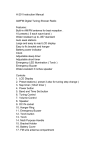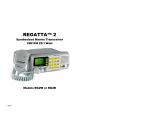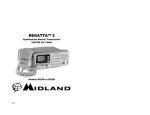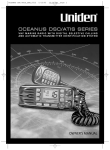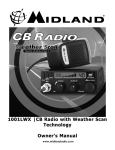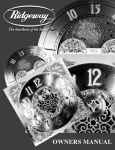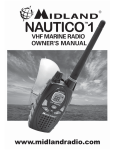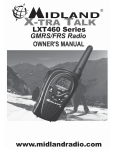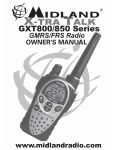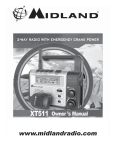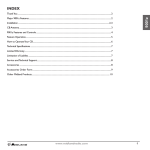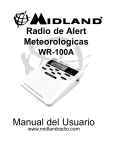Download Midland Regatta 1-W
Transcript
Fixed Mount VHF Marine Radio with DSC Owner’s Manual www.midlandradio.com Model RG1 Owner’s Manual Table of Contents Welcome to the World of Midland Electronics Major REGATTA 1 Features FCC Licensing Information - Station License - International Station License - Radio Call Sign - Canadian Ship Station License Warnings Included with your REGATTA 1 Controls and Indicators -Front Panel -Back Panel -LCD Indicators Installation Operation Distress Digital Selective Calling GPS (NMEA0183) Input Connection Specification USA Channel and Function Chart International Channel and Function Chart Canada Channel and Function Chart Technical Specifications Troubleshooting Care and Maintenance Limited Warranty Service and Technical Support Other Midland Products Page 2 3 3 4 4 4 4 4 5 6 7 7 8 8 9-10 11-13 14 15 16 17 18 19 20 21 22 23 24 25 www.midlandradio.com Model RG1 Owner’s Manual Welcome to the World of Midland Electronics Congratulations on your purchase of the Midland REGATTA 1 VHF Marine Radio. This fixed mount radio gives you 2-way vessel to vessel and vessel to shore communication- for both safety and navigational purposes. With the REGATTA 1, you can call for help, get information from other boaters and talk to loch or bridge tenders. In addition, in the USA and Canada you can access the NOAA weather broadcast with the 10 weather channels and be alerted to severe weather emergencies with the weather alert feature. The REGATTA 1 is a quality piece of electronic equipment, skillfully constructed with the finest components. This radio is designed for reliable and trouble-free performance for years to come. Enjoy! Major REGATTA 1 Features: • • • • • Submersible- meets JIS7 specifications All Marine Channels- US, International and Canada 10 NOAA Weather Channels NOAA Weather Alert DSC Digital Selective Calling – for security on the water and the ability to make quick calls automatically • Channel Scan • HI/LO Power Settings • Last Channel Memory • Tri-Watch • Large, High Visibility Display • PA Function • Distress Button • Instant Emergency Channel 16/9-for instant access to channel 16 (the universal marine channel for emergency contact) • Front Firing Speaker • NMEA connection – use the interface cable supplied for easy connection from transceiver to optional GPS system • Connection to an external speaker (optional) – for listening to communications further away from the transceiver In an effort to constantly improve product quality, product characteristics are subject to change without notice. Page 3 www.midlandradio.com Model RG1 Owner’s Manual FCC Licensing Information The REGATTA 1 radio complies with the FCC (Federal Communication Commission) requirements that regulate the Maritime Radio Service. This radio incorporates a VHF FM transceiver designed for use in the frequency range of 156.025 to 162.550 MHz. It requires 13.8 volts DC and has a switchable RF output power of one (1) or (25) watts. The transceiver is capable of DSC (Digital Selective Calling) operation. The radio operates on all currently allocated marine channels and is switchable for use according to U.S.A., International, or Canadian regulations. Station License An FCC ship station license is no longer required for any vessel traveling in U.S.A. waters which uses a VHF marine radio, RADAR, or EPIRB (Emergency Position Indicating Radio Beacon), and which is not required to carry radio equipment. However, any vessel required to carry a marine radio on an international voyage, carrying a HF single side band radiotelephone, or carrying a marine satellite terminal must obtain a station license. FCC license forms and applications for ship and land stations can be downloaded through the Internet at http://www.fcc.gov/ Forms can also be obtained by calling the FCC at 888-225-5322. International Station License If your vessel will be entering the sovereign waters of a country other than the U.S.A. or Canada, you should contact that country’s communications regulatory authority for licensing information. Radio Call Sign Currently, the FCC does not require recreational boaters to have a license. The United States Coast Guard recommends that the boat’s registration number and state of registry (e.g., Illinois 1234 AB) be used as a call sign and be clearly visible on the vessel. Canadian Ship Station License You need a Radio Operator’s Certificate if your vessel is operated in Canadian waters. Radio Operator training and certification is available from the Canadian Power Squadron. Visit their website (http://www.cps-ecp.ca/), contact the nearest field office or write: Industry of Canada, Radio Regulatory Branch, Attn: DOSP, 300 Slater Street, Ottawa, Ontario, Canada K1A 0C8. Registration of your Marine Transceiver For using GMDSS and DSC functions, the operator must have a GMDSS radio operator's certificate (SRC or LRC) and apply for a ships MMSI number at the local radio authority. Without MMSI number the radio can only be used as conventional VHF marine radio without DSC. Your distributor may program your radio according to your needs. Page 4 www.midlandradio.com Model RG1 Owner’s Manual Warnings General This device has been tested for compliance with digital marine device limits. These limits were created to allow for reasonable protection against damaging interference. This device is to be used solely as an aid to navigation. Its settings may be influenced by diverse factors, such as defects or malfunction of the device, environmental conditions or improper use. It is the user's responsibility to observe reasonable prudence and judgement in navigation, and as such this device should not be considered a substitute for reasonable prudence and judgement. Do not open the radio for any reason! REGATTA 1's precision mechanics and electronics require expertise and specialized equipment; for the same reason, the radio should under no circumstances be realigned as it has already been calibrated for maximum performance. Unauthorized opening of the transceiver will nullify the warranty. Radio Frequency / Installation Midland recommends following the requirements for prevention of radio frequency exposure. Unauthorized changes or modifications to this device may invalidate conformity to the FCC Regulations. All changes or modifications must be approved in writing by MIDLAND RADIO CORPORATION. This VHF DSC transceiver generates and irradiates electromagnetic energy (EME) at radio frequency (RF), and as such must be installed and placed in operating conditions that are in conformity with the instructions contained in this manual and with current regulations. Not following these instructions can cause personal injury and/or malfunction of the device. •Do not use REGATTA 1 before connecting a suitable antenna that is in perfect working condition - although REGATTA 1 is protected, this may seriously damage the stages of transmission power. •Do not use transmit before ensuring proper connection of the antenna. During transmission, remain at a minimum distance of 3 feet from the antenna. Environmental •Pay attention to ambient conditions - although REGATTA 1 is designed to operate under the most severe conditions, it is important to avoid exposure to environments that are excessively humid or dusty, or to temperatures outside the -20°C to +50°C range. Also avoid exposure to direct sunlight. •Avoid jarring and excessive vibration - REGATTA 1 is built to resist mechanical shock and vibration as long as these are within the norm for any electrical device. •Do not use this device in potentially explosive environments. A single spark may cause an explosion. Page 5 www.midlandradio.com Model RG1 Owner’s Manual Included with your REGATTA 1 Transceiver and Microphone Surface Mount Kit Microphone Mounting Kit Page 6 DC Power Cord GPS Interface Cable www.midlandradio.com Model RG1 Owner’s Manual Controls and Indicators Front Panel PTT Button Channel Up Button Power/ Volume Knob Channel Down Button DSC Button Squelch Knob Select Button 16/9/ Tri -Watch Button HI/LO Power Button PA Button Distress Button Weather Alert Button Scan/ UIC Button Power/Volume Knob: (On/Off/Volume) - Turns the unit On or Off and adjusts the speaker volume. Squelch Knob: Rotate this knob to eliminate background noise when a signal is not being received. PA Button: Press this key to enable the PA (Public Address) feature. Weather Alert Button: Press this key to listen to active NOAA Weather channels. Press and hold this key for 2 seconds to place the radio into the Weather Alert mode. Scan/UIC Button: Press this key once to activate channel scan mode. Press and hold for 2 seconds to change channel modes from USA to CANADIAN to INTERNATIONAL. Distress Button: Press this key to send a signal of distress in case of emergency. HI/LO Power Button: Press this key to change the transmit power to either High or Low. Default mode is high power. 16/9/Tri-Watch Button: Press this key instantly to change to Channel 16, Channel 9 or current channel. Pressing and holding this key for 2 seconds will activate the Triple Watch Feature. Select Button: In DSC mode, this key is used to makes selections. DSC Button: Press this button to enter DSC mode. Channel Up/Down Buttons: These keys are used to arrow through the channels. Page 7 www.midlandradio.com Model RG1 Owner’s Manual Controls and Indicators cont... Back Panel Antenna Connector NMEA /GPS Accessory Connector DC External Speaker/ Connectors PA Connector LCD Indicators 1 2 3 13 4 6 8 10 5 7 9 11 12 1. LO (Low)- Indicates transmit output is 1 Watt. 2. HI (High)- Indicates transmit output is 25 Watts. 3. TX (Transmit)- Indicates radio is transmitting. 4. TRI (Triple Watch)- Indicates Triple Watch Mode is in effect. 5. SCAN- Indicates channel scan mode is in effect. 6. WX- Indicate Weather Channel Mode has been activated. 7. Alert- Indicates the weather alert mode is activated. 8. INT- Indicates International Channel Mode. 9. USA- Indicates US Channel Mode. 10. CAN - Indicates Canada Channel Mode. 11. DSC- Indicates the radio is in the DSC mode. 12. Globe- Indicates a GPS data receiver is receiving a signal. 13. Channel Display- Indicates Channel Number in use. Page 8 www.midlandradio.com Model RG1 Owner’s Manual Installation The REGATTA 1 will only operate with a nominal 13.8 volt negative ground battery system. It is important to carefully determine the most suitable location for your radio on your vessel. Electrical, mechanical, and environmental considerations must all be taken into account. You should select the optimum relationship among these considerations. Features which should be considered are: 1. The universal mounting bracket may be installed on either the top or bottom of a shelf, on a bulkhead, or for overhead mounting. 2. The accessory speaker wires can be used with an external speaker. 3. All connections are "plug-in" type for easy removal of the radio. 4. Front fire built-in speaker allows for convenient in-dash mounting. Choosing a Location Some important factors to consider in selecting the location for your REGATTA 1. 1. Select a location that is free from spray and splash. 2. Keep the battery leads as short as possible. Direct connection to the battery is most desirable. If direct connection can not be made with the supplied power lead, any extension should be made with #10 AWG wire. Long extensions should use larger gauge wire. 3. Keep the antenna lead as short as possible. Long antenna leads can cause substantial loss of performance for both receiving and transmitting. 4. Locate your antenna as high as possible and clear from metal objects. The reliable range of coverage is a direct function of the antenna height. 5. Select a location that allows free air flow around the heat sink on the rear of the radio. 6. Select a location well away from the ship’s compass. Engine Noise Suppression Interference from the noise generated by the electrical systems of engines is sometimes a problem with radios. The REGATTA 1 has been designed to be essentially impervious to ignition noise and alternator noise. However, in some installations it may be necessary to take measures to further reduce the effect of noise interference. All DC battery wires, antenna lead, and accessory cables should be routed away from the engine and engine compartment, and from power cabling carrying high currents. Page 9 www.midlandradio.com Model RG1 Owner’s Manual Installation cont... Antenna Considerations A variety of antennas are available from a number of quality suppliers. It is recommended you draw upon the advice of your Midland dealer in determining a suitable antenna for your vessel and range requirements. In general, communication range is increased by using a high-gain antenna placed as high as possible above the water line. Antennas should be located away from metal objects. Antennas should not have excessively long coaxial feed cables. Antenna Selection and Installation REGATTA 1 has been designed to accommodate all of the popular marine VHF antennas. However, the selection and the installation of the antenna is the responsibility of the user or installer. The FCC has determined that excessive radiation poses a health risk to people near radio transmitting antennas. Therefore, the antenna used with this radio should be installed using the following guidelines to insure a suitable distance between the antenna and persons close by. Small whip antennas (3 dB) or smaller should be installed keeping at least three feet separation distance between the radiating element and people. Larger antennas (6 dB or 9 dB) should be installed keeping at least a six foot separation distance. No person should touch the antenna or come into the separation distance when the radio is transmitting. CAUTION: The antenna(s) used for this transmitter must not be co-located or operating in conjunction with any other antenna or transmitter. This device is approved with emissions having a source-based time-averaging duty factor not exceeding 50%. The safe operating distance between the general population and the antenna when transmitting is 35 inches. Failure to observe these restrictions will result in exceeding the FCC RF exposure limits. Installing the REGATTA 1 After you have carefully considered the various factors affecting your choice of location, position the radio (with the bracket, microphone, power cord, antenna and any auxiliary cables installed) into the selected location to assure there is no interference with the surrounding items. Mark the location of the mounting bracket. Remove the bracket from the radio and use it as a template to mark the holes to be drilled for the mounting hardware. Drill the holes and mount the bracket with hardware compatible with the material of the mounting surface. Then attach the Note: Do not use any other mounting knobs than the ones enclosed. radio to the mounting bracket Do not insert the knobs without using the included knobs. attaching the bracket. Connect the red wire of the supplied power cord to the positive (+) battery supply. Connect the black wire of the power cord to the negative (–) battery supply. The power cord is equipped with a fuse to protect the radio. Use only a 7 ampere fast blow fuse for replacement. Connect the power cord to the keyed connector on the power "pigtail". Connect the antenna and all other auxiliary cables and accessories. Install the radio in the mounting bracket and connect all cables and accessories to the appropriate jacks and connectors. Page 10 www.midlandradio.com Model RG1 Owner’s Manual Operation Power On/Off: Turn the unit On by rotating the PWR/VOL control clockwise. Adjust the volume to a comfortable level. When you turn the unit On, you will hear a beep, and the channel number will display on the LCD. Note: When you turn On the radio for the first time after purchase, the channel 16 will appear on the LCD. Last Channel Memory: The REGATTA 1 memorizes the last channel selected before you turn Off the radio. For example, if you turn Off the radio on CH 8, it will be on that channel when turned back On. Squelch: Turn SQUELCH fully clockwise. This raises the “Squelch Gate” so high that only very strong signals can get through. Turn SQUELCH fully counterclockwise until you hear a hiss. This lowers the “Squelch Gate” so that everything gets through - noise, weak signals, and strong signals. Turn SQUELCH back clockwise until the hiss stops. Now the “Squelch Gate” allows only strong signals through. Page 11 www.midlandradio.com Model RG1 Owner’s Manual Operation Cont... Coast Guard Channel 16/9 : To access Coast Guard Channel 16 or Channel 9 communications, press 16/9/TRI. You can access Coast Guard Channel 16 instantly while tuned to another channel. Press 16/9/TRI again for Channel 9 Calling communications. Press 16/9/TRI a third time to return to the channel selected prior to accessing Coast Guard Channel 16/Channel 9 commnunications. The display will indicate the selected channel. Tri-Watch: Tri-Watch monitors Channel 16, Channel 9, and the current Marine Channel. To activate Tri-Watch, press and hold 16/9/TRI for 2 seconds. TRI appears on the LCD, indicating Tri- Watch mode is in effect. If a signal is received on either Channel 16 or Channel 9, the radio remains on that channel until the signal ends. Press and hold 16/9/TRI for 2 seconds to cancel the Triple Watch mode. Manual Tuning: To manually select a channel, press the CHANNEL UP or DOWN button. Communication channels are located on channel 01-28 and 60-88. Weather channels are located on channels WX 0-9. Weather Channels: To select Weather Channels 0-9, press WX/ALERT. The radio will go to the last selected Weather Channel. Press the CHANNEL UP/DOWN buttons to select a different Weather Channel. To exit from Weather Channel press WX/ALERT. The radio returns to the previously selected Marine channel. Weather Alert: To activate Weather Alert mode, press WX/ALERT for 2 seconds. ALERT will display on the LCD. When the radio is in Alert mode, it scans weather every 7 seconds. When an alert is received, the unit will switch to the current weather channel and emit a loud siren noise. To turn off the siren, press WX/ALERT. Transmitting: The REGATTA 1 transmits on fifty-four marine frequencies and receives on eighty marine frequencies. Channel 70 of the USA, International, and Canadian frequencies, and channel 15 of the USA frequencies, and WX CH – are for receiving only. The radio transmits on channel 70 when sending DSC information. Your radio will not transmit on these channels. PA Function: Press the PA button once to enter PA function. The LCD will display PA instead of channel. You must have an external PA speaker connected in order for this to work. To exit PA mode, press the PA button again. Page 12 www.midlandradio.com Model RG1 Owner’s Manual Operation Cont... Setting Transmit (TX) Power NOTE : It is important to remember to use the LO position in port or for short range communications. 1. When you turn the radio On for the first time, the unit is automatically set to transmit at 25 watts (HI). 2. Press HI/LO to change the transmitter output to 1 watt (LO). 3. Press HI/LO again to change back to 25 watts (HI). Note: Each time the HI/LO is pressed a short tone sounds. CH13 is set as 1 watt (LO) channel. On the LO power channels, you cannot set the transmit power to HI. LO power channels are 13 and 67 for USA, and 13, 15, 17, and 20 for CAN. Channel Scan: Press the SCAN/UIC button to begin rapidly scanning channels for an active channel. If a channel is active, the unit will lock on that channel. To begin scanning again, press the SCAN/UIC button again. If no active channel is found, press the SCAN/UIC button to end scan mode. Channel Band Selection: Press the SCAN/UIC button for 6 seconds to switch the unit to International band. Repeat again to switch to Canada band. Repeat a 3rd time to return to US band. User MMSI Federal MMSI's are issued by the National Telecommunications and Information Administration. Non-Federal MMSI's are issued by the Federal Communications Commission (FCC). You will need to obtain a nine digit MMSI number and program it into the REGATTA 1. The information obtained from the application is useful to the U.S. Coast Guard to help in search and rescue operations. To obtain an MMSI number, visit one of the following websites: http://wireless.fcc.gov/marine or http://www.boatus.com/mmsi/ This portion of the SETUP menu will allow you to program an MMSI, (Maritime Mobile Service Identity) for sending and receiving DSC calls. Setting the MMSI: To enter MMSI setup mode, with the unit off, press and hold the DSC button while simultaneously turning the radio on. Using the up and down arrows, enter the nine digit number. Note: Only 2 digits at a time can display on the LCD while programming the MMSI into the radio. The first digit represents the number position 1~9 the second digit is the selected mmsi number 0~9. Press SELECT button after each digit is selected to advance to the next digit. After setting the MMSI number, turn off the unit. Please note: You can only program your radio once with an MMSI number. After that, send your radio to Midland for factory service. Page 13 www.midlandradio.com Model RG1 Owner’s Manual Distress Note: You must set the user MMSI in order to send a Distress call. This feature will allow you to transmit a Distress call. 1. In order to transmit a Distress call, press and hold DISTRESS for 5 seconds. 2. You will see SL in the display. Press the SELECT button and the Distress call will be transmitted. 2. The Distress call is transmitted and it waits for about 210 - 270 seconds. This is continued internally. After the Distress call has been sent, the Distress alert will sound every other second, and it also "watches" for a transmission between CH16 and CH70 until an acknowledgment signal is received from the Coast Guard shore station. To cancel the Distress call, press 16/9/TRI. 3. If an acknowledgment is not received, the Distress call is repeated until an acknowledgment is received from theCoast Guard shore station. Note: If the radio receives a Distress call an emergency alert will sound. Page 14 www.midlandradio.com Model RG1 Owner’s Manual DIGITAL SELECTIVE CALLING Digital Selective Calling is a process of establishing a radio call, it has been chosen by the International Maritime Organization (IMO) as an international standard for establishing VHF, MF and HF radio calls. Digital Selective Calling has also been selected as part of the Global Maritime Distress and Safety System (GMDSS). This service will let you instantly send a Distress call with GPS position (when optional GPS receiver is connected to the REGATTA 1) to the US Coast Guard and other vessels within range of the transmission. DSC will also let you initiate or receive distress, urgency, safety, position information and routine calls to or from another vessel outfitted with a DSC transceiver. Press the DSC Button to enter DSC Call Mode. DSC has 2 options as follows: 1. INDIVIDUAL - Press the DSC button once. IN will be displayed on the LCD. - Press Select to choose INDIVIDUAL MODE. - You will then need to enter the MMSI number for the individual you would like to call. Use the CH UP/DOWN arrows to choose the 1st digit. Press select to move to the next digit. It will be blinking. Repeat this procedure until all 9 digits have been programmed. When finished press SELECT and the unit will scan one by one through the digits entered. Press SELECT again and it sends the DSC call to the MMSI number entered. Note: Only 2 digits at a time can display on the LCD while programming the MMSI into the radio. 2. ALL SHIPS This radio has the ability to send 3 types of all ships calls. The following are examples of what these types of calls would be used for: Urgency - This call is for a vessel not yet in Distress, but may have a serious problem. Safety - This call is used for a reason like debris in the water. Routine - This call is used for normal calls. How to Use - Press the DSC button once. Use the CH UP/DOWN buttons to toggle to ALL SHIPS MODE. AL will be displayed on the LCD. - Press SELECT to choose ALL SHIPS MODE. The radio will then have you choose which type of ALL SHIPS message you would like to send: URGENCY (UR), SAFETY (SA), or ROUTINE(RO). Note: ROUTINE calls tune to the previously selected channel. - Use the CH UP/DOWN buttons to toggle to URGENCY or SAFETY. When chosen, press SELECT to transmit the ALL SHIPS DSC call. When sending either an URGENCY or SAFETY message, all radios will automatically move to channel 70 until all of the data is received. After your selected URGENCY or SAFETY ALL SHIPS call is transmitted, the radio will switch to Channel 16. You should wait a few minutes before transmitting the ALL SHIPS call information again. Page 15 www.midlandradio.com Model RG1 Owner’s Manual REGATTA1 GPS Input Connection Specification Your RG1 transceiver can be used with an external GPS device. Attach the included GPS adaptor cable (black) to the radio’s GPS connector (tan). Then, the GPS adaptor cable can be connected to a GPS device. When connected to a GPS receiver, the RG-1 transceiver will display the Midland Globe icon. When the globe icon is displayed, the GPS NMEA data is available for transmitting distress or DSC calls. If the GPS is disconnected or the RG1 is not receiving NMEA data from the GPS, a minutelong warning tone will sound (can be deactivated by pressing any button). This tone will sound every 4 hours. In conjunction, the globe icon will flash indicating no GPS information available. Many GPS units allow you to configure the NMEA0183. This can be done through the GPS set-up menu. Page 16 www.midlandradio.com Model RG1 Owner’s Manual VHF Marine Channel and Functions (USA Channels) Page 17 www.midlandradio.com Model RG1 Owner’s Manual VHF Marine Channel and Functions (International Channels) Page 18 www.midlandradio.com Model RG1 Owner’s Manual VHF Marine Channel and Functions (Canadian Channels) Page 19 www.midlandradio.com Model RG1 Owner’s Manual Technical Specifications General Channels.........................All 49 USA, 54 Canadian & 57 international marine channels Frequency generation...................................................................... PLL synthesizer Frequency range.....................................................TX from 156.025 to 157.425 MHz RX from 163.275 to 162.550 MHz Antenna Impedance.....................................................................................50 Ohm Power supply...................................................................................13.8 VDC ±15% Operating temperature..............................................................from -20°C to +50°C Size (HxLxW).................................................................................70×185×175 mm Weight (device only)......................................................................1.26 Kg / 2.80 Lb. Transmitter Output power...............................................................High (HI): 25W/Low (LO):1W Modulation Type..................................................................................................FM Microphone.......................................................................................condenser type Hum and noise attenuation...............................................................................35dB Audio distortion...................................................................................................5% Harmonics reduction......................................................................HI: 70dB/LO:60dB Receiver Sensitivity @ 20 dB Sinad...............................................................................<0.3 V S/N ratio (20dB)...............................................................................................0.5 V Squelch sensitivity...........................................................................threshold 0.15 V Adjacent channel rejection................................................................................70dB Audio output power ..........................................................................>2W @ 8 Ohm Audio distortion.................................................................................................10% Note: these values are average. Actual values may be subject to variation. Page 20 www.midlandradio.com Model RG1 Owner’s Manual Troubleshooting Page 21 www.midlandradio.com Model RG1 Owner’s Manual Care and Maintenance Your REGATTA 1 is a precision crafted piece of electronic equipment and you should treat it accordingly. Due to the rugged design, very little maintenance is required. However, a few precautions should be observed: • If the antenna has been damaged, you should not transmit except in the case of an emergency. A defective antenna may cause damage to your radio. • You are responsible for continued FCC technical compliance of your radio. • Never open the device (transceiver or microphone) as this may compromise the water seal. • If the device becomes dirty or dusty, do not use alcohol, solvents or abrasives to clean it. Use only a soft cloth, slightly dampened with water. For more persistent cases, use a mild detergent. Page 22 www.midlandradio.com Model RG1 Owner’s Manual Limited Warranty Midland Radio will repair or replace, at its option without charge, your MODEL REGATTA 1 VHF Marine transceiver which fails due to a defect in material or workmanship within THREE YEARS following the initial consumer purchase. This warranty does not include the cost of labor for removal or re-installation of the product in a vehicle or other mounting. Accessories have a 90 day warranty from date of purchase, including any connector cords or adapters. Performance of any obligation under this warranty may be obtained by returning the warranted product, freight prepaid, along with a readable copy of the original dated sales receipt to: Midland Radio Corporation Warranty Service Department 5900 Parretta Drive Kansas City, MO 64120 Note: The above warranty applies only to merchandise purchased in the United States of America or any of the territories or possessions or from U.S. military exchange. This warranty gives you specific legal rights, and you may also have other rights, which vary from state to state. Midland Radio Corporation 5900 Parretta Drive Kansas City, MO 64120 Tel: (816) 241-8500 E-mail: [email protected] URL: www.midlandradio.com Model REGATTA 1 Page 23 www.midlandradio.com Model RG1 Owner’s Manual Service and Technical Support * If you have a problem which you believe requires service, please call first and speak with a service technician. Many problems can be remedied over the phone without returning the unit for service. For Technical Support Contact: Midland Radio Corporation 5900 Parretta Drive Kansas City, Missouri 64120 Phone: (816) 241-8500 Fax: (816) 241-5713 E-mail: [email protected] Website: www.midlandradio.com If after talking with technical support you still feel your unit needs to be returned for service, follow the below instructions: 1. Pack the unit in its original box and packing. Then pack the original box in a suitable shipping carton. Caution: Improper packing may result in damage during shipment. 2. Include the following: a. full description of any problems b. daytime telephone number, name & address 3. For warranty service include a photocopy of the bill of sale from an authorized dealer or other proof of purchase showing the date of sale. 4. You do not need to return accessory items (Fused DC power cord, mounting hardware, Owners Guide) unless they might be directly related to the problem. 5. A flat rate of $55.00 will apply to repairs not covered by warranty or units that are over three years old. Send only cashier’s check, money order or Master Card or Visa card number. Send to: Midland Radio Corporation 5900 Parretta Drive Kansas City, Missouri 64120 Page 24 www.midlandradio.com Model RG1 Owner’s Manual Page 25 www.midlandradio.com MIDLAND RADIO CORPORATION 5900 Parretta Drive Kansas City, MO 64120 Call 816.241.8500 visit us at http://www.midlandradio.com Note: Features & Specifications are subject to change without notice. MIDLAND is not responsible for unintentional errors or omissions on its packaging.


























